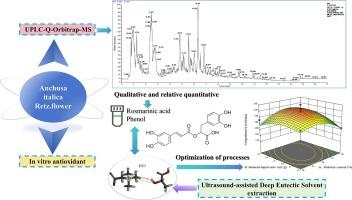Study on ultrasonic-assisted deep eutectic solvent extraction process and in vitro antioxidant of Anchusa italica Retz. Flowers
IF 8.7
1区 化学
Q1 ACOUSTICS
引用次数: 0
Abstract
Anchusa italica Retz. Flowers (Airfs) is a perennial herb belonging to the Boraginaceae family. A variety of pharmacological agents are employed in the treatment of a multitude of cardiovascular disorders. The study employs ultra-performance liquid chromatography coupled with quadrupole-time of flight mass spectrometry (UPLC-Q-Exactive Orbitrap-MS) to elucidate the complex chemical composition of these flowers, identifying a multitude of bioactive constituents. It is noteworthy that rosmarinic acid (RA) emerged as a predominant compound, a finding underscored by its high relative content of 39.8511% in the methanolic extract of the flowers.
The innovative approach involved the use of a deep eutectic solvent (DES), a green extraction medium, which, when combined with ultrasonic assistance, resulted in a notable enhancement of the extraction yield of total polyphenols and RA. The optimization of this extraction process was achieved through a meticulous response surface methodology, which identified critical factors and their optimal conditions. These included a water content of 29.051 % and a material-liquid ratio of 20.961 mL/g. The optimal conditions were determined to be an extraction time of 35.725 min, an ultrasonic power of 240.342 W.
In vitro antioxidant assays further substantiated the therapeutic potential of Anchusa italica Retz. flowers. RA demonstrated remarkable DPPH and ABTS radical scavenging capabilities, with rates exceeding 90%. The comprehensive evaluation value (CEV), derived from the total polyphenol content (TPC) and RA, was optimized under the aforementioned conditions, yielding a CEV of 222.452.
The optimized extraction method presents a sustainable and efficient protocol for the isolation of bioactive compounds from natural sources, thereby underscoring the significance of this research in the field of natural product chemistry and ultrasonics Sonochemistry.

超声波辅助深共晶溶剂萃取工艺及 Anchusa italica Retz.花。
Anchusa italica Retz.花(Airfs)属于婆婆纳科多年生草本植物。在治疗多种心血管疾病中使用了多种药剂。本研究采用超高效液相色谱-四极杆飞行时间质谱法(UPLC-Q-Exactive Orbitrap-MS)来阐明这些花的复杂化学成分,并鉴定出多种生物活性成分。值得注意的是,迷迭香酸(RA)是一种主要化合物,其在花的甲醇提取物中的相对含量高达 39.8511%,这一发现凸显了这一点。创新方法包括使用深共晶溶剂(DES)这种绿色萃取介质,并结合超声波辅助,显著提高了总多酚和 RA 的萃取率。该萃取工艺的优化是通过细致的响应面方法实现的,该方法确定了关键因素及其最佳条件。这些因素包括 29.051 % 的含水量和 20.961 mL/g 的料液比。体外抗氧化试验进一步证实了 Anchusa italica Retz.RA 具有出色的 DPPH 和 ABTS 自由基清除能力,清除率超过 90%。根据总多酚含量(TPC)和 RA 得出的综合评价值(CEV)在上述条件下得到了优化,CEV 为 222.452。优化后的萃取方法为从天然资源中分离生物活性化合物提供了一种可持续的高效方案,从而凸显了该研究在天然产物化学和超声声化学领域的重要意义。
本文章由计算机程序翻译,如有差异,请以英文原文为准。
求助全文
约1分钟内获得全文
求助全文
来源期刊

Ultrasonics Sonochemistry
化学-化学综合
CiteScore
15.80
自引率
11.90%
发文量
361
审稿时长
59 days
期刊介绍:
Ultrasonics Sonochemistry stands as a premier international journal dedicated to the publication of high-quality research articles primarily focusing on chemical reactions and reactors induced by ultrasonic waves, known as sonochemistry. Beyond chemical reactions, the journal also welcomes contributions related to cavitation-induced events and processing, including sonoluminescence, and the transformation of materials on chemical, physical, and biological levels.
Since its inception in 1994, Ultrasonics Sonochemistry has consistently maintained a top ranking in the "Acoustics" category, reflecting its esteemed reputation in the field. The journal publishes exceptional papers covering various areas of ultrasonics and sonochemistry. Its contributions are highly regarded by both academia and industry stakeholders, demonstrating its relevance and impact in advancing research and innovation.
 求助内容:
求助内容: 应助结果提醒方式:
应助结果提醒方式:


